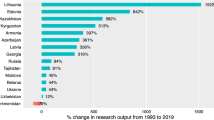Abstract
Using a collection of papers gathered from the Web of Science, and defining disciplines by the JCR classification, this paper compares the disciplinary structure of the G7 countries (representing high S&T level countries) and the BRIC countries (representing fast breaking countries in S&T) by using bibliometric methods. It discusses the similarity and the balance of their disciplinary structure. We found that: (1) High S&T level countries have a similar national disciplinary structure; (2) In recent years the disciplinary structure of the BRIC countries has become more and more similar to that of the G7 countries; (3) The disciplinary structure of the G7 countries is more balanced than that of the BRIC countries (4) In the G7 countries more emphasis goes to the life sciences, while BRIC countries focus on physics, chemistry, mathematics and engineering.







Similar content being viewed by others
References
Almeida, J. A. S., Pais, A. A. C. C., & Formosinho, S. J. (2009). Science indicators and science patterns in Europe. Journal of Informetrics, 3(2), 134–142.
Frame, J. D. (1977). Mainstream research in Latin America and the Caribbean. Interciencia, 2, 143–148.
Glänzel, W. (2000). Science in Scandinavia: A bibliometric approach. Scientometrics, 48(2), 121–150.
Glänzel, W., Debackere, K., & Meyer, M. (2008). ‘Triad’ or ‘tetrad’? On global changes in a dynamic world. Scientometrics, 74(1), 71–88.
Glänzel, W., Leta, J., & Thijs, B. (2006). Science in Brazil. Part 1: A macro-level comparative study. Scientometrics, 67(1), 67–86.
Glänzel, W., & Schlemmer, B. (2007). National research profiles in a changing Europe (1983–2003): An exploratory study of sectoral characteristics in the triple helix. Scientometrics, 70(2), 267–275.
Hu, X. J., & Rousseau, R. (2009). Comparative study of the difference in research performance in biomedical fields among selected Western and Asian countries. Scientometrics, 81(2), 475–491.
Hu, W. J., Zhang, H. W., Shao, R. H., & Song, G. (2010). Study on equilibrium of academic journal allocation based on Gini coefficient and the Theil Index. Journal of Intelligence, 29(11), 54–58.
King, D. A. (2004). The scientific impact of nations. Nature, 430(6997), 311–316.
Kostoff, R. N., DelRio, J. A., Cortes, H. D., Smith, C., Smith, A., Wagner, C., et al. (2007). Clustering methodologies for identifying country core competencies. Journal of Information Science, 33(1), 21–40.
Kozlowski, J., Radosevic, S., & Ircha, D. (1999). History matters: The inherited disciplinary structure of the post-communist science in countries of central and Eastern Europe and its restructuring. Scientometrics, 45(1), 137–166.
Liang, L. M., Havemann, F., Heinz, M., & Wagner-Dobler, R. (2006). Structural similarities between science growth dynamics in China and in western countries. Scientometrics, 66(2), 311–325.
Nijssen, D., Rousseau, R., & Van Hecke, P. (1998). The Lorenz curve: A graphical representation of evenness. Coenoses, 13(1), 33–38.
Rousseau, R., Van Hecke, P., Nijssen, D., & Bogaert, J. (1999). The relationship between diversity profiles, evenness and species richness based on partial ordering. Environmental and Ecological Statistics, 6(2), 211–223.
Yue, H. J. (2008). Prediction and relative dynamic performance on field of research of China. Studies in Science of Science, 26(3), 530–538.
Acknowledgments
The authors give much thanks to Prof. Ronald Rousseau for his valuable advice about using Gin index to measure the evenness.
Author information
Authors and Affiliations
Corresponding author
Appendix
Rights and permissions
About this article
Cite this article
Yang, L.Y., Yue, T., Ding, J.L. et al. A comparison of disciplinary structure in science between the G7 and the BRIC countries by bibliometric methods. Scientometrics 93, 497–516 (2012). https://doi.org/10.1007/s11192-012-0695-8
Received:
Published:
Issue Date:
DOI: https://doi.org/10.1007/s11192-012-0695-8



